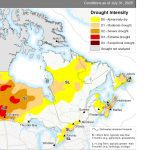NEW YORK, N.Y. (Reuters) – Mosaic’s chief executive officer won’t say whether his company is for sale, but he clearly thinks the U.S. potash and phosphate producer would make a great acquisition, given its strengths and growth prospects.
From a 100-year supply of potash reserves to a partnership in a lucrative Canadian potash cartel, Mosaic is a “very compelling investment,” James Prokopanko said.
“We’ve got well-established and technically very sound mines and operations and well-run businesses,” he said.
Read Also

Alberta eases water access for riparian restoration
Alberta government removes requirement for temporary diversion licence to water plants up to 100 cubic metres per day for smaller riparian restoration projects
“I could understand interest” in the company.
Speculation has circulated for months that mining giants Vale or BHP Billiton might buy Mosaic, which owns potash mines on three continents.
Takeover premiums and investor confidence in the sector’s prospects have helped fertilizer stocks outpace most major North American indexes in recent months, but share prices of fertilizer makers are now well below the record highs seen last year.
Mosaic, which is mostly owned by privately held Cargill, has repeatedly declined comment on market speculation about a takeover.
Still, acquiring Mosaic could instantly transform BHP or Vale into a major potash producer and buy them a seat in Canpotex, the overseas potash marketing arm of the big three Saskatchewan producers: PotashCorp, Mosaic and Agrium.
Prokopanko would not talk directly about a possible sale, but noted the costs and time to develop a new, or greenfield, potash or phosphate mine can often be prohibitive.
“I have little doubt that if mining companies want to expand, and they see that this is an attractive industry, they say, ‘geez, it’s so expensive to greenfield, why don’t we buy somebody?’ “Well, to that point, I don’t know that anybody’s been tested to see what these things are worth. I’d argue that current facilities are worth what it costs to replace them, and that is very, very expensive.”
Demand for key fertilizers likely will grow over the next five years, though not at a steady pace, Prokopanko said.
“It’s not going to be a straight, linear line,” he said. “But it will, over time, as it has for the last 30 years, show a steady increase in demand.”
Analysts are concerned that a late planting season in North America this year will make it difficult to apply fertilizer before snow falls, which could hurt fertilizer demand and producers in the near term.
Sales will come
Prokopanko is not concerned, however.
“If we don’t sell it in the fall, we’ll sell it in the spring.”
Prokopanko wants to expand Mosaic’s potash capacity by more than five million tonnes over the next 10 years from about 10 million tonnes today.
To reach that goal, the company is spending $5 billion US.
“I do know that in three years, and four years and five years, we’re going to look over our shoulder and be selling more fertilizer than we do today,” he said.
Prokopanko expects genetically modified seeds to increase his business because they are like fast cars that need more fuel.
“There’s no replacing potash and phosphate,” Prokopanko said.
“The plant needs what the plant needs.”
















